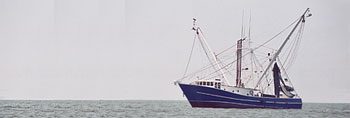The
commercial shrimping industry along the Gulf of Mexico and
South Atlantic coasts protects aquatic resources in those
waters in several ways, among them by outfitting trawl nets
with Turtle Excluder Devices (TEDs)
and Bycatch Reduction Devices (BRDs)
to reduce incidental mortality through unintended catch.
These devices are required by law in federal waters. In state
waters, shrimpers are required by Texas, Florida, North Carolina,
South Carolina and Georgia to use both. BRDs are not required
in Louisiana, Mississippi or Alabama state waters. (Visit
the Louisiana Department of Wildlife & Fisheries site
at http://www.wlf.state.la.us/apps/netgear/index.asp?cn=lawlf&pid=106
for Commercial Fishing Regulations; note sections for "Area"
and "Methods of Taking") Although some types of
trawl nets are exempt from these regulations, the shrimpers
using them must comply with regulations restricting tow times.
Through these efforts, the populations of endangered and threatened
species of sea turtles as well as some finfish species can
be conserved.
Conservation
of marine resources is of interest to all commercial fishers.
Those in other fisheries and/or using other gear types of
fishing gear are also trying to reduce the incidental take
of marine life. Those in the reef fish bottom longline fishery
are considering use of circle hooks. (For more information
about circle hooks, visit http://www.mslabs.noaa.gov/mslabs/docs/pubs.html)
In other parts of the country, gillnet fisheries have been
closed or new gear developed. For example, in Hawaii, longliners
are testing an underwater setting chute to protect some species
of sea birds from accidentally swallowing or grasping baited
hooks. (Read the article "New
Fish-Bait Device Helps Protect Seabirds" (60KB
PDF file) for more information) Each of these devices
is designed to help unintended catch escape or prevent their
capture with the least possible loss of the intended catch.
The commercial
shrimp fishing industries of the Gulf of Mexico and South
Atlantic cooperatively developed, modified, and tested TEDs
and BRDs with assistance from NOAA Fisheries and pro-commercial
fisheries organizations such as the Gulf and South Atlantic
Fisheries Foundation, Inc. NOAA Fisheries has further assisted
in the research and development of these gears by conducting
underwater hydrodynamic tests and indentifying promising devices
that could further reduce incidental bycatch.
Controlling
or reducing bycatch is a global issue. This portion of the
Sea Grant Fisheries Web site is dedicated to providing information
and an archive of articles only about management information
associated with the use of TEDs and BRDs shrimp trawl nets
in the Gulf of Mexico and South Atlantic regions.

Photo
by Robert Ray, Louisiana Sea Grant

Development
of this portion of the Louisiana Sea Grant Fisheries Web site
was funded by
the Gulf & South Atlantic Fisheries Foundation, Inc. under
NOAA cooperative agreement #NA16FM2817.
The statements, findings, conclusions, and recommendations
are those of the author(s) and do not necessarily reflect
the views of the Gulf & South Atlantic Fisheries Foundation,
Inc., NOAA, or the Department of Commerce.
Fisheries
regulations are subject to change often.
At the time this information was posted, these regulations
were correct.
For more information, contact John Mitchell of NOAA Fisheries
at John.Mitchell@noaa.gov